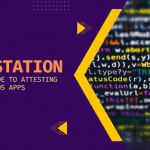The last few years have seen the internet progress through multiple evolution stages. The recent one has been witnessed in the form of a massive shift in the internet’s architecture from a read or write model to the latest one known as Web3.0.
Web3.0 differs from its predecessors because users and the entire community are given internet ownership instead of a few big and centralized corporations. Web3 uses dynamic blockchain technology to create a more decentralized web. Unlike independent websites hosted on a particular server, blockchain offers several advantages, including higher resiliency and better protection against censorship.
Although Web3 is a newfound technology that is claimed to significantly increase the security of the websites that use it, the fact remains that it is decentralized and based on blockchain, cryptocurrencies, and NFTs. This makes companies less prepared for new risks and web3 security concerns, and the winner in this race will be the one who can forecast and prevent all possible security issues.
To help you navigate the security challenges better, this post discusses some of the best practices for Web3 security.
Ready to protect your app?
Start 30-days FREE TRIAL. No credit card required. Deliver Secure Mobile Apps Faster in minutes with the leader in application security.

Web3 Security
As exciting as the prospect of this new technology release seems, Web3 security remains a primary concern for everyone. Regardless of the size of your organization (startup or big enterprise), here are some of the best practices that you can follow to mitigate the risks related to Web3 security –
1. Go with the Security by Design Approach
Security is paramount for any new technological innovation to succeed in the market. This is where the concept of security by design comes in.
With this approach, Web3 developers can come up with products with robust infrastructures and completely secure code that are impossible to breach by hackers.
Developers here need to proactively take the appropriate steps to reduce the cyber attack surface. And one of the best ways to do this is by securing zero-trust frameworks. Another advantage of the security by design principle is that it helps in ensuring separate and limited privileges.
2. Prioritize Security Audits
Web3 is a new technology requiring developers to focus not only on time-to-market but also the time to test and thoroughly evaluate the project code. To do this efficiently, one of the excellent ways is to leverage a professional and trusted outsourced security auditor equipped to find the potential bugs your internal security teams may have missed.
Not prioritizing security audits can soon prove harmful, leading to various cybersecurity concerns and massive losses. This makes it crucial to ensure that all known vulnerabilities are properly secured before cybercriminals and hackers use them to their advantage.
Further, since Web3 developers may not understand larger security governance that goes parallel with traditional software development, it makes sense to conduct smart contract security audits on a regular basis. These audits increase the chances of catching all potential bugs early on, thus allowing you to maintain the development pace and develop a secure application.
3. Better User-Controlled Key Management
The capacity of users to carry out transactions in the Web3 paradigm is majorly dependent on cryptographic keys, which are quite challenging to handle.
Since entire businesses are based on key management, the risk associated with managing private keys is one of the main factors leading consumers to select hosted wallets instead of non-custodial wallets. This will necessitate robust technological changes.
Since this kind of Web3 security innovation is one of the most exciting developments in the open, there is a growing need to work collectively towards more innovative solutions.
4. Strategic Application of Security
Applying security strategically is as important for Web3 security as pursuing the security by design approach. Developer teams need to be proactive about considering the kind of blockchain technology they will be using for the project. They must choose between utilizing public blockchains such as Ethereum (ETH) and private blockchains.
This is important because, unlike public blockchains, which allow anyone to join with various levels of anonymity, private blockchains necessitate users to confirm their identity, access privileges, and other similar details.
A few of the other factors that you need to consider here are-
- Every blockchain, public, private, or hybrid (multichain, cross-chains, sidechains) comes with its unique set of challenges. It will affect the overall security of your decentralized application, thus requiring its own unique security approach.
- Developers should take the necessary steps to address threats such as phishing and what impact it might have on workflows and the overall project architecture during the software development life cycle.
- Web3 developers should also take into account data quality and various manipulation risks present in every iteration.
5. Two-Factor Authentication
Social hacking using visually relatable information is one of the common types of threats today. It is used to entice users into giving out their personal or confidential information to hackers.
Web3 space is where this is commonplace by cloning popular applications so they look exactly like the real ones. Then, the duplicate ones collect a user’s details to access the account on the real application.
Two-factor authentication is an excellent way to deal with this as it reduces the access of hackers/scammers in such situations because the process involves validating the device used for authentication purposes rather than just passwords.
6. Consider the Overall Web3 Market Dynamics
The scope of Web3 is much wider than simply being another standard technology. It comes with a range of other dynamics, including cultural, legal, and economic, to consider. For instance, when it comes to identity, some of the Web3 integrations can directly contradict existing regulatory compliance guidelines such as GDPR and KYC.
Likewise, organizations and developers also need to consider that regulations governing the crypto space vary significantly from one country/jurisdiction to another.
Apart from this, there needs to be some brainstorming on how your Web3 projects may attract and incentivize cybercriminals, as Web3 technology is quite vulnerable to social engineering attacks. An excellent example is common DeFi hacks in the space because of cross-chain weaknesses and code exploits.
7. A Clear Procedure to Report Vulnerabilities
Another best practice for companies is establishing a definitive method for reporting possible vulnerabilities. This should be done while ensuring that the details of the issues, especially for critical vulnerabilities, should not be publicized.
The idea here is to strategically reduce the time for exploitation to a point where once a hacker finds out, they won’t have enough time to manipulate the vulnerabilities. You can also think of a bug bounty program as a part of this process to entice users to reveal any bugs responsibly.
8. Security Prioritization from Start to End
To mitigate Web3 security risks, developers must remember that security is an ongoing process that should be approached consistently from the beginning. For instance, security here should begin by thoroughly assessing the overall system architecture. Failing to consider the security at the architecture level can make it easy for hackers to breach and cause harm to your systems.
Likewise, developers must assess and evaluate the chances of malicious intent or potential threats during the software development process. This threat assessment allows them to think about the eventualities or chances of disruptions during the software development lifecycle. Some of the questions to answer here include –
- What are the areas to work on?
- What are the aspects that need monitoring from going wrong?
- The different measures wise individuals take to address the challenges and risks.
- Assessment of the steps taken to mitigate security risks.
Overall, keep in mind that you’ll require some expertise to mitigate the security risks associated with Web3. And if you lack that knowledge, it is best to collaborate with an expert partner or hire someone with a dedicated focus and capabilities to address these challenges.
The Way Ahead
Web3 is still in its nascent stage, and significant development will be needed before it completely takes over Web2. As the technology evolves further in the future, some security risks may be resolved, and new ones may be created.
However, what is important here is to take a proactive approach and follow the best practices (as listed above) to ensure Web3 and blockchain security.
In the end, it is important to remember that Web3 is a complicated space to understand and implement security. But if security professionals take up the challenge in their stride, several measures can also be implemented in other software security environments.
Ready to protect your app?
Start 30-days FREE TRIAL. No credit card required. Deliver Secure Mobile Apps Faster in minutes with the leader in application security.







